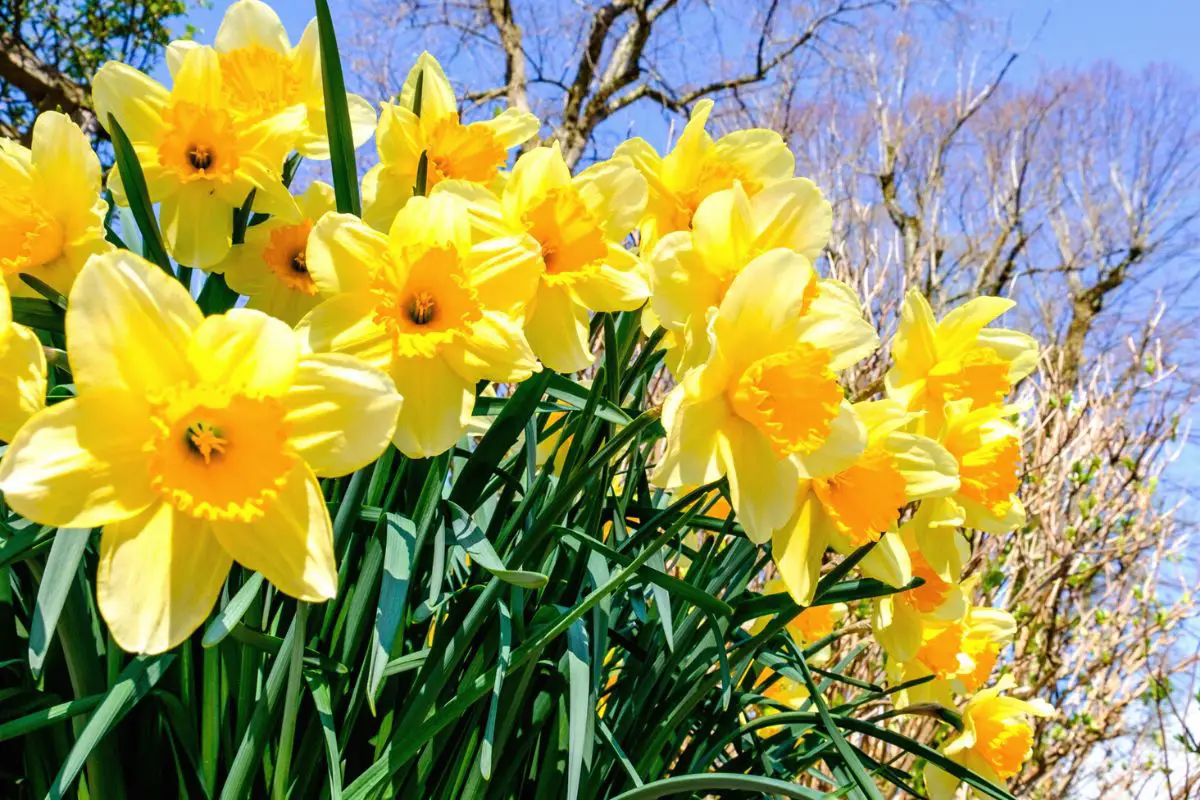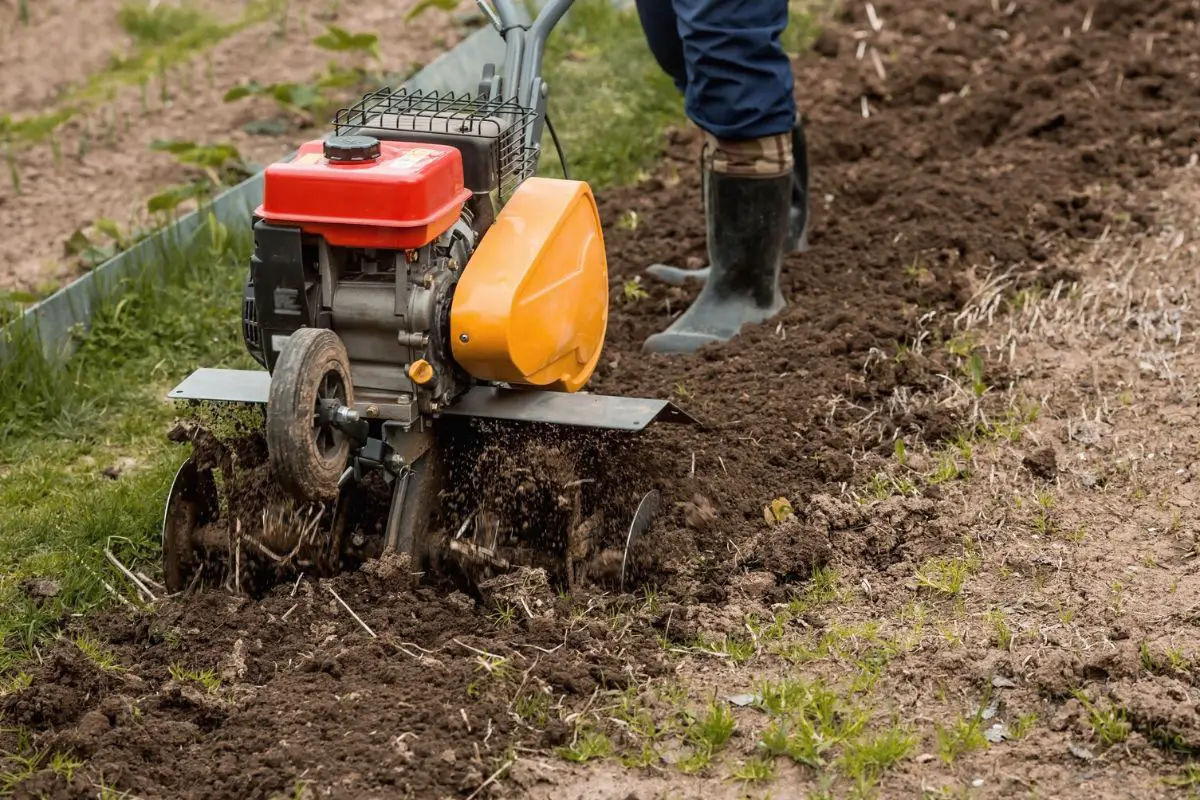While staghorn ferns can be grown in pots like other houseplants, it’s best to mount them to allow them to grow horizontally, the way they grow naturally in the wild. Mounting and securing a plant as potentially substantial as the staghorn fern can feel a little intimidating, especially if it’s your first time doing so.
Different ways to mount a staghorn fern include:
- Mount your staghorn fern on a plaque.
- Attach your staghorn fern to a tree.
- Use a large rock as a support.
- Secure your Fern on a wire frame.
Staghorn ferns are epiphytes, meaning they don’t grow in soil but instead attach themselves to surfaces such as trees in the wild. Thus, these plants present challenges to growers who wish to mount them securely. In this article, I’ll share four practical ways to mount a staghorn fern to various surfaces.
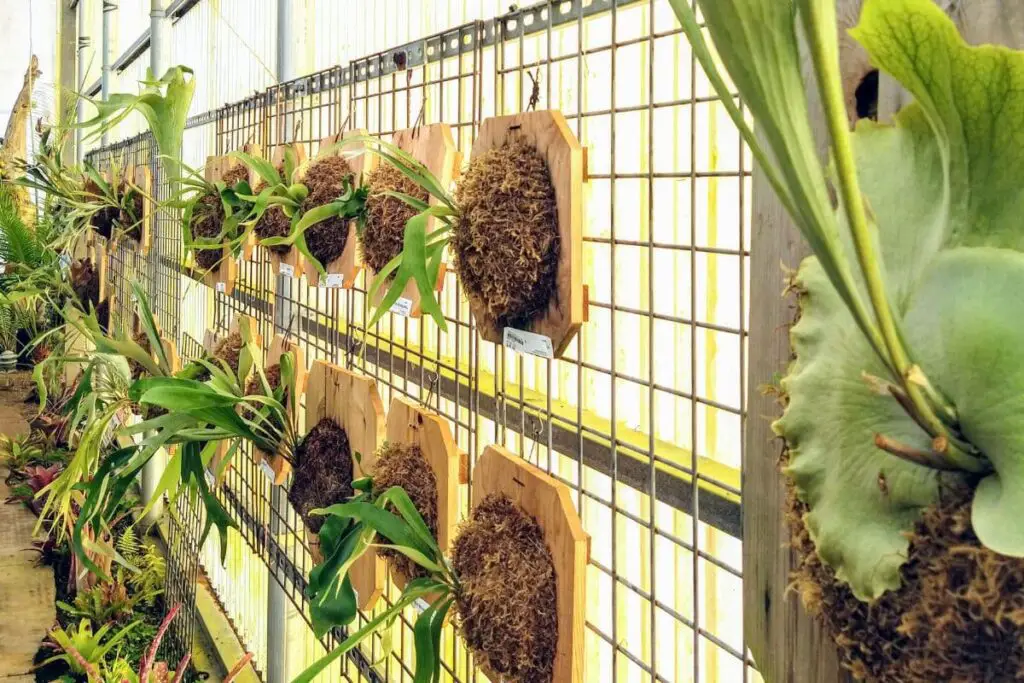
1. Mount Your Staghorn Fern on a Plaque
We’ll start with the most straightforward entry on our list. By mounting your staghorn fern to a plaque or a similar wooden surface, you’ll get much more flexibility in using the beautiful plant as a piece of indoor decor.
It’s essential to use the correct material for the surface. Since you’ll frequently be misting and watering your staghorn fern (these are water-loving plants), you’ll need something that doesn’t rust or rot under damp conditions.
Most wooden plaques used for mounting purposes are cedar, which has excellent resistance against rot. Redwood, cork, and teak are hardwoods that won’t rot quickly.
Let’s get down to the actual mounting process. It will require some handiwork.
The items you’ll need are:
- Your staghorn fern
- A wooden plaque that is sizable enough to accommodate the base of your plant
- A growing medium (typically Sphagnum moss)
- A 30 lbs (13 kg) fishing line should be enough in most cases, but you may need a more robust fishing line if you work with a more massive plant
How to Mount to a Plaque
- Gently remove your staghorn fern from its pot or container. Take care not to damage the plant’s roots or basal fronds.
- Place it at the center of your wooden plaque. The entire base of the plant should sit comfortably within the boundaries of the plaque. There should be some room to spare at the edges.
- Cover the base of the fern with plenty of your growing medium. You can use sphagnum moss, sheet moss, or other organic media. Your growing medium should be able to drain water well. Cover only the roots, do not cover the basal fronds.
- Optional: You can wet it slightly if you’re using moss. This process will help it clump together and make things a bit easier.
- Use a fishing line or twine to secure the growing medium. You will have to weave it several times around the plaque before the entire contents of the plant and growing medium have enough support.
- Tilt the plaque gradually until it is fully horizontal to judge whether or not the staghorn fern has enough support. This method will ensure that the plant is secure.
Attaching or Hanging Your Fern
When you’ve secured the base of the plant to the plaque, you can then attach it to or hang it from a wall with nails, wire, or twine.
Most dedicated mounting boards will come with an attached cord. If yours didn’t, you can drill two tiny holes into the board and then run some twine or fishing line through them to make a DIY suspension cord.
Your staghorn fern should be facing in the direction of the nearest source of sunlight. This location is essential because the plant will grow outdoors toward the sunlight, and you don’t want it growing crooked.
Staghorn ferns mounted on wooden plaques make for impressive decorations. They’re more prominent than the average plant, and their horizontal growth causes them to stand out.
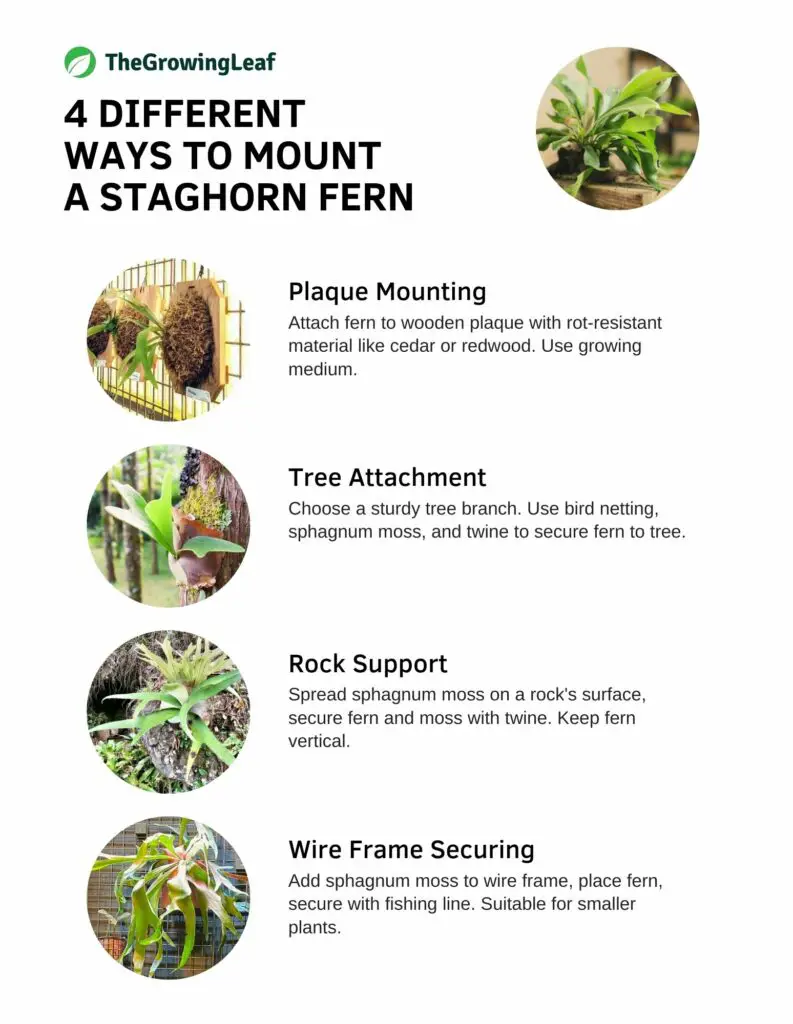
2. Attach Your Staghorn Fern to a Tree
You could mimic nature and put it on a tree instead—which is perfect if you want a creative way to decorate your lawn or garden. This placing also offers notable health benefits for your staghorn fern as it most mimics its natural state.
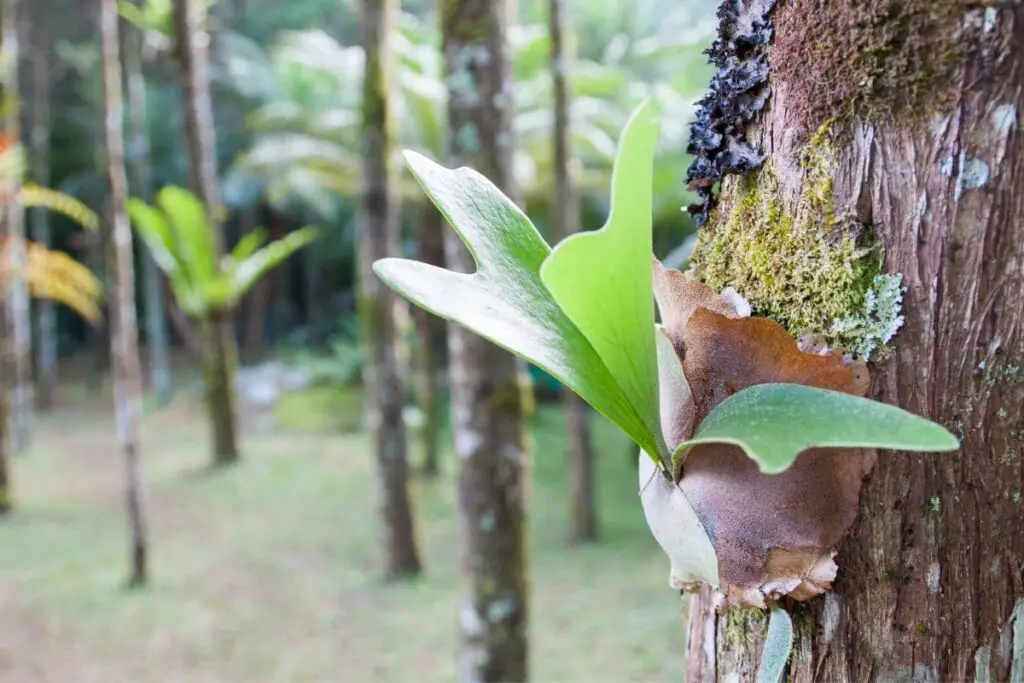
You should consider these essential points:
- The tree must be sizable enough to support the staghorn fern: These bulky plants can grow up to weigh hundreds of pounds, and all that weight will bear down on whatever branch or trunk is suspending it.
- Choose this method in higher hardiness zones: While the cover of the tree will provide some protection from the cold, outdoor temperatures will drop far below indoor temperatures during winter. Like most plants, staghorn ferns can’t tolerate sub-zero temperatures.
- To address this common concern quickly – no, staghorn ferns don’t hurt trees: These plants use their basal fronds to acquire nutrients and water from the air and rain. Your fern won’t steal any resources from the host tree.
Now, how do you attach a staghorn fern to a tree?
Well, you’ll want to use a smaller, younger plant for two main reasons. First, a sizable, adult staghorn fern would be far too impractical to set up. Secondly, the young fern will grow in a way that allows it to receive maximum support from the tree.
The items you’ll need are the following:
- Bird netting
- Sphagnum moss
- Fir bark
- Twine or fishing line
How to Attach It to a Tree
- Lay the bird netting on a flat surface.
- Add some sphagnum moss.
- Add the fir bark—this will stabilize our growing media, which is essential because our staghorn fern won’t have much initial support.
- Keep adding the moss and bark until you have a 2:1 mixture (with more moss). It would be best to have a nice mound of growing media.
- Place your staghorn fern gently inside this growing media. The media should cover the roots, but the basal fronds should sit above the mound of our growing mix.
- Run some twine through the outer ends of the netting to close it up. You should now have a nice, compact layer of the growing mix covering your staghorn’s root mass from all sides.
- Place the final product at the crotch between the tree’s trunk and branch.
- Run fishing lines through the netting and around the tree’s trunk or branch. This method will ensure the staghorn fern is safely secured.
And you’re all done. Right now, the entire plant is standing still on the crotch of the tree, supported by the fishing line in case a force acts on it. However, it will slowly start attaching to the tree on its own.
Within a few months, the fern will have attached to the tree and require no external support to keep itself there. After about six months, you can safely remove the fishing line.
3. Use a Large Rock as a Support
Are you surprised to learn that staghorn ferns can grow on a rock? Well, they can grow on pretty much any surface. The real problem is finding a practical way to support their heavy growth.
This method is another excellent way to add aesthetics to your outdoors. This mounting process is similar to mounting to a wood board but a bit more challenging.
How to Mount to a Rock
Here’s what you need to do:
- Grab a rock of a suitable size. The surface you’ll be planting on needs to be larger than the root mass of your staghorn fern.
- Spread some sphagnum moss on the rock’s surface.
- Secure the moss to the stone with twine or a fishing line.
- Place the plant’s roots in the moss.
- Secure the fern to the rock with twine or a fishing line.
That’s about it. Simple enough, right? The only downside to rock-mounting is that you’ll have to keep the staghorn fern vertical. As we discussed earlier, these plants prefer horizontal growth as they mature.
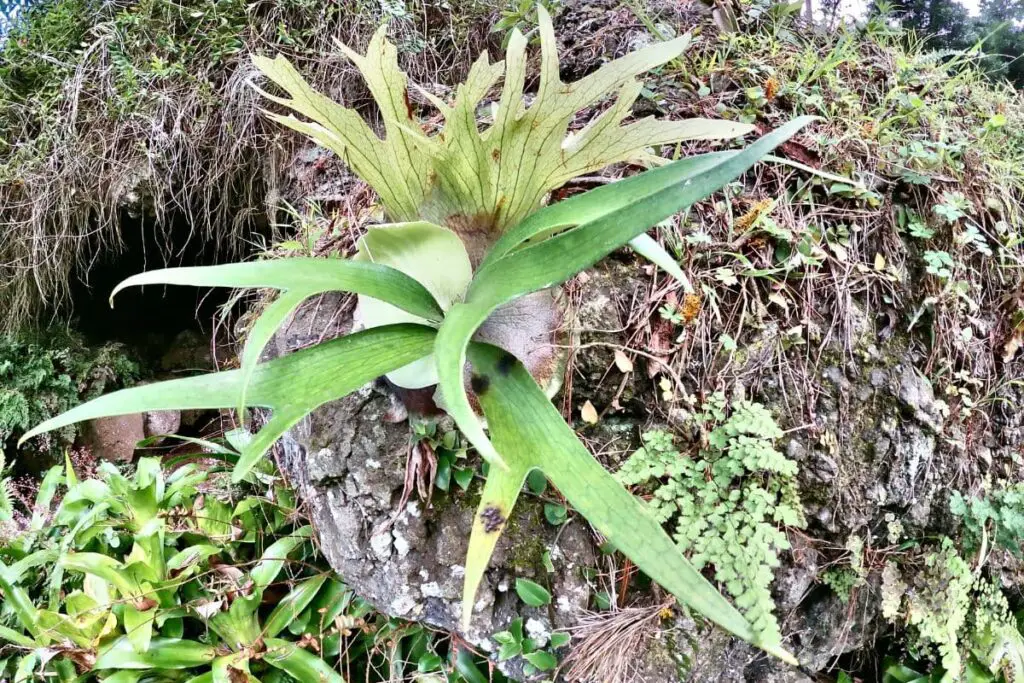
4. Secure Your Fern on a Wire Frame
This method is a unique way to mount a staghorn fern and a reasonably straightforward process. Just remember that metal may rust when exposed to moisture over time.
How to Secure to a Wire Frame
- Add some sphagnum moss to the wireframe.
- Place your staghorn fern onto the frame.
- Secure your fern with a fishing line.
And voila. This method is only suitable for smaller plants and won’t be a permanent mount. Staghorn ferns grow slowly but survive for decades, so they can live to become gigantic.

